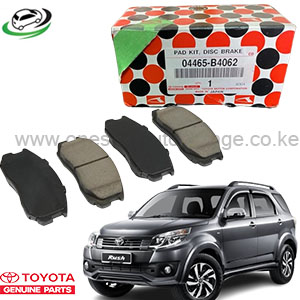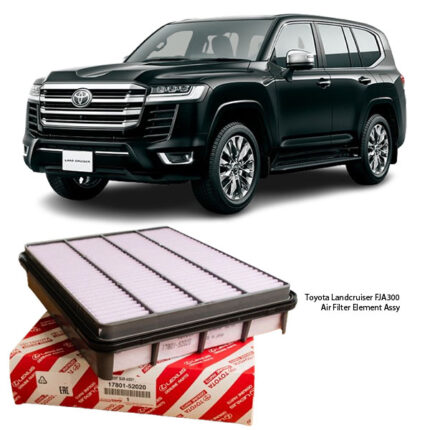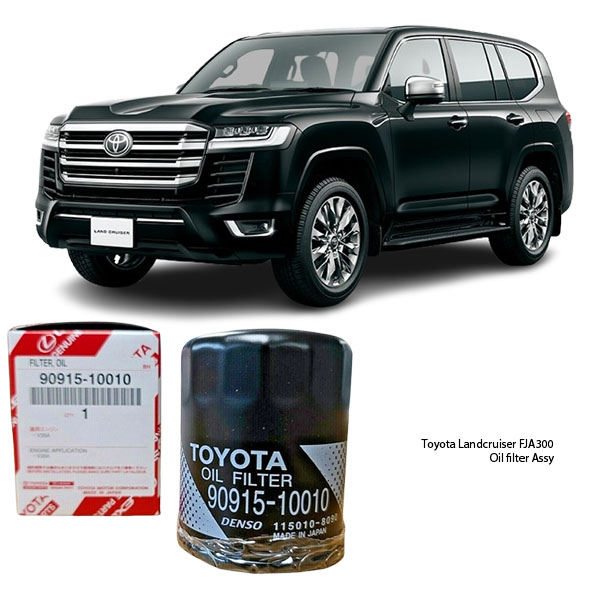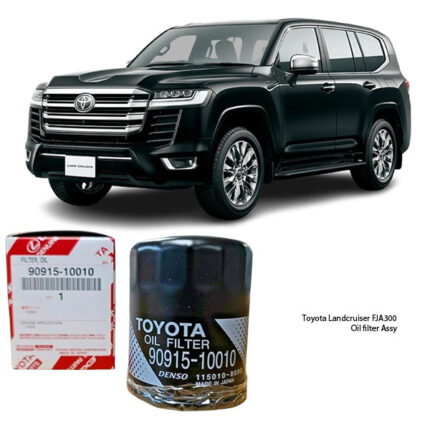Get Toyota Landcruiser FJA300 Oil Filter Assy 90915-10010 in Kenya
The oil filter assembly is a crucial component in an engine’s lubrication system. It removes contaminants, dirt, metal particles, and sludge from engine oil, ensuring clean oil circulates through the engine. This helps extend the life of the engine, maintain performance, and reduce wear on internal components.
Without a properly functioning oil filter assembly, dirty oil can cause engine damage, reduced efficiency, and increased emissions.
In this guide, we’ll explore:
- The function of an oil filter assembly
- Different types
- Common symptoms of failure
- Maintenance tips
1. Function of an Oil Filter Assembly
An oil filter assembly consists of the oil filter, filter housing, and mounting components. Its primary role is to clean the engine oil before it reaches critical engine parts.
1.1. Filtering Contaminants
- Oil collects dirt, carbon deposits, and tiny metal particles as it circulates
- The filter removes these contaminants, preventing them from damaging engine components
1.2. Maintaining Oil Pressure
- The filter regulates oil flow, ensuring a consistent supply to the engine
- If clogged, it can cause low oil pressure, leading to engine failure
1.3. Protecting Engine Components
- Reduces wear and tear on components such as pistons, camshafts, crankshafts, and bearings
1.4. Enhancing Engine Efficiency
- Clean oil improves engine performance, reduces fuel consumption, and extends engine life
1.5. Assisting in Temperature Regulation
- Some oil filter assemblies come with built-in cooling systems to regulate oil temperature
2. Types of Oil Filter Assemblies
Oil filter assemblies vary based on design, function, and filtration technology.
2.1. Mechanical Oil Filters
- Uses filter media (paper, cotton, or synthetic fibers) to trap contaminants
- The most common type found in passenger vehicles
2.2. Cartridge Oil Filters
- A replaceable filter element without a metal housing
- More environmentally friendly than traditional spin-on filters
2.3. Spin-On Oil Filters
- A self-contained unit with a built-in housing
- Easy to replace but generates more waste compared to cartridge filters
2.4. Magnetic Oil Filters
- Uses magnets to capture metallic debris
- Often used in performance and racing engines
2.5. High-Efficiency Oil Filters
- Designed for extended oil change intervals
- Uses synthetic fiber filtration media
2.6. Bypass Oil Filters
- Filters oil more finely than a standard filter
- Used in heavy-duty vehicles where ultra-clean oil is required
2.7. Thermal Oil Filters
- Includes a heating element to keep oil at an optimal temperature
- Helps in cold weather conditions
3. Symptoms of a Failing Oil Filter Assembly
An oil filter assembly wears out over time. Here are the most common warning signs:
3.1. Low Oil Pressure Warning Light
- A clogged oil filter restricts flow, triggering the oil pressure warning light
3.2. Engine Noise and Knocking Sounds
- Insufficient oil supply causes increased friction
- May lead to engine knocking or metallic grinding noises
3.3. Poor Engine Performance
- A dirty filter reduces oil circulation, causing the engine to hesitate, lose power, or consume more fuel
3.4. Dirty Exhaust Smoke
- If the oil filter is not removing contaminants, it can lead to excessive black smoke from the exhaust
3.5. Oil Leaks
- A damaged or improperly installed filter assembly can cause oil leaks
4. Causes of Oil Filter Assembly Failure
Several factors contribute to premature oil filter assembly failure:
4.1. Lack of Maintenance
- Failure to change the oil filter during regular oil changes leads to clogging
4.2. Poor-Quality Oil Filters
- Cheap or counterfeit filters may have weak filtration material, leading to poor oil cleaning
4.3. Extreme Temperature Conditions
- Cold weather can cause oil to thicken, making it harder for clogged filters to pass oil
4.4. Overextended Oil Change Intervals
- Using oil beyond its recommended lifespan accelerates filter blockage
4.5. Incorrect Installation
- An incorrectly fitted filter can cause leaks and inefficient oil filtration
5. Maintenance and Replacement
5.1. When to Replace an Oil Filter Assembly
- Every 8,000 – 16,000 km (5,000 – 10,000 miles) or as per manufacturer recommendations
- More frequent replacements if you drive in harsh conditions, dusty areas, or extreme temperatures
5.2. Inspection Tips
✅ Check for oil leaks around the filter housing
✅ Monitor oil pressure for sudden drops
✅ Observe the oil color – Dark, sludgy oil indicates the filter isn’t functioning properly
5.3. DIY vs. Professional Replacement
✅ DIY Replacement: If you have basic tools, replacing a spin-on or cartridge oil filter is simple
✅ Professional Mechanic: Necessary for complex filter assemblies in some modern vehicles
5.4. Steps for Changing an Oil Filter Assembly
- Drain the Engine Oil – Remove the drain plug and let oil flow out
- Remove the Old Oil Filter – Use an oil filter wrench to loosen it
- Clean the Filter Mounting Area – Wipe away old oil and debris
- Install the New Oil Filter – Apply fresh engine oil to the new filter’s gasket before tightening
- Refill with Fresh Oil – Ensure you use the correct oil type and quantity
- Check for Leaks and Run the Engine – Let the engine run for a few minutes to ensure proper oil circulation
6. Choosing the Right Oil Filter Assembly
When buying an oil filter, consider:
6.1. Compatibility with Your Vehicle
- Check the manufacturer’s specifications before purchasing
6.2. OEM vs. Aftermarket Filters
- OEM (Original Equipment Manufacturer): Designed for your vehicle’s exact specifications
- Aftermarket Filters: Often cheaper but may not provide the same level of filtration
6.3. Quality of Filtration Media
- Synthetic fiber filters provide better filtration than standard paper filters
6.4. Durability and Efficiency
- High-mileage oil filters last longer and are designed for extended oil change intervals
6.5. Brands to Consider
- Trusted brands include Bosch, Mann-Filter, WIX, Hengst, Mahle, K&N, and Fram
7. Conclusion
The oil filter assembly plays a vital role in removing contaminants, maintaining oil pressure, and protecting engine components. Regular inspection, timely replacements, and using high-quality filters ensure your engine stays in top condition.
Follow us on Facebook for more parts.




